|
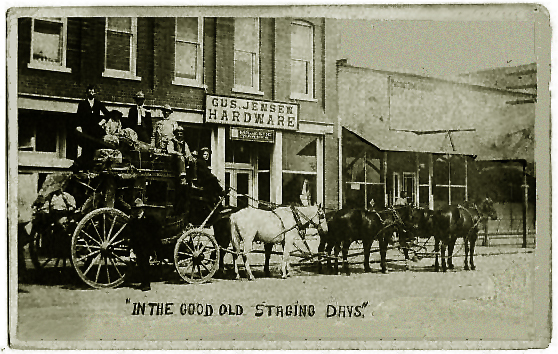
The Ft. Steele and Saratoga Stage in fron of Gustave Jensen's Hardware, approx. 1895.
Gustave "Gus" Jensen (1860-1917) moved to Saratoga in 1891. He was an immediate sucess in the hardware business selling hardware, furniture, farm implements and mining
supplies. Ultlimately Jensen bought out the stock of the Saratoga Merchantile Co. The Saratoga Mercantile was, itself, a successor to Wilbur Hugus' store which he had acquired from his
brother. As was typical of that type of business the store also had an undertaking department.
In addition to the store, Jensen owned the Jensen's Hall, the Regina Ranch, and sawmill properties. In 1907, he with Isaac C. Miller, John E. Osborne and William Daley opened the
First National Bank of Saratoga. The bank was initially located at one end of the building depicted and used furniture that came from
the Rawlins National Bank. He served initially as cashier of the bank. In 1909, the Cosgriff Brothers acquired controlling interest in the bank.
The Cosgriffs were more interested in State chartered banks in that a state bank could loan money on real estate and had a
larger loan limit. Therefore, the Platte Valley Bank of Saratoga was organized as a successor for the
First National Bank. In January 1917, Jensen died of pneumonia.
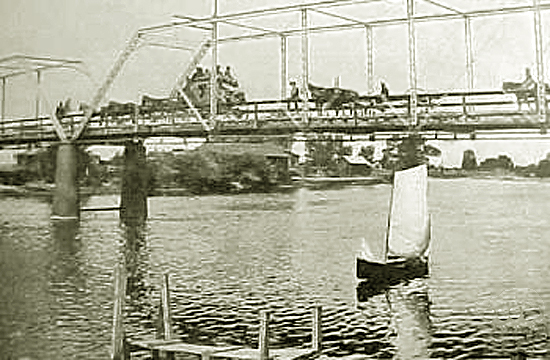
Stage crossing bridge across the North Platte, Saratoga, approx 1907.
Originally, the main point of entry to the Saratoga Valley from the railroad was Fort Steele. Fort Steele had two hotels, the Worthy Hotel operated by
Ed Worthy and Fort Steele Hotel operated by E. B. Marsh. In 1896, Ed Worthy (actual name Ivan Esworthy) became incrasingly delusional and forgetful.
He forgot, as an example, that he sold his hotel to John Swanson for $1,000. He started to claim that he had done work for
others and threatened to collect through the use of a Winchester. Thus, he was ultimately adjudged insane, his brother appointed as
guardian of his estate and he was sent off the the State Asylum in Evanson where he died in 1898.
Jenson's Hardware served as the express office for the stage line both as operated by Ed Worthy and subsequently operated by
Charles M. Scribner. Scribner brought in his first coach from Ft. Steele on Feb. 16, 1897, through heavy snow in only 4 1/2 hours.
Scribner was famous for his teams of six white horses Among his passengers on the initial test run were the
Cosgriff Brothers who later established banks and a mercantile in Saratoga. The Saratoga Sun, Feb. 18, 1897, marvelled that
they brought with them Denver newspapers that had been published the same day. Later Scribner moved the line running from Wolcott to Saratoga and Encampment.
Prior to the arrival of the Saratoga and Encampment
Railway, stages provided the means of transportation from the Union Pacific to Saratoga. Freight was carried on bull trains or
18 horse freighters.
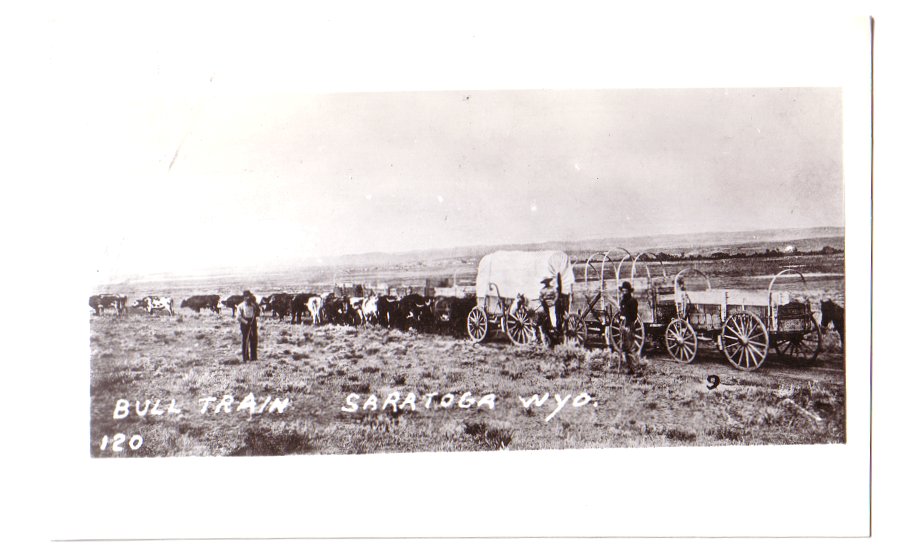
Bull Train near Saratoga, undated.
In August 1907, the Saratoga and Encampment Railway reached Saratoga and a year
later the railroad reached Encampment. The mail contract was transferred from Charles Scribner to the railroad. Scribner leased the line from
Saratoga to Encampment to E. L. Gould. Although stages run by others carried mail to outlying mining camps, main stage service out of
Saratoga and Encampment was discontinued.
Scribmer sold some of the equipment but not the coach. In 1919, Charley Scribner
fell and broke his hip. He developed pneumonia and died.
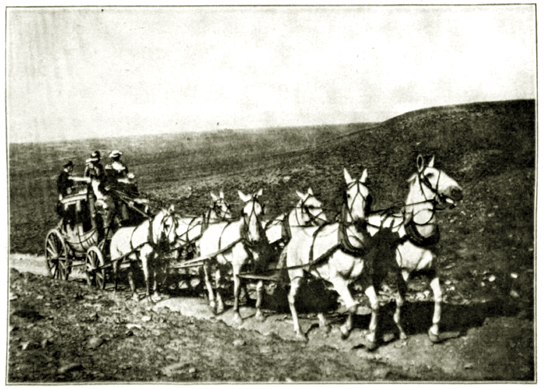
Last Run out of Saratoga.
The old coach depicted above at one time belonged to Wells-Fargo and Company. Following Scribner's death it sat out at his ranch
folorn and abandoned until 1926 when W. L. Petrikin, President of Great western Sugar Company in Denver purchased the coach. His
daughter was a graduate of Wells College in Aurora, Cayuga County, New York. Wells College was founded by
Henry Wells. Petrikin had the coach fully restored to its appearance when owned by Wells-Fargo and presented it to the
college which still owns it. For further discussion of the Scribner Stage Line see
Encampment.
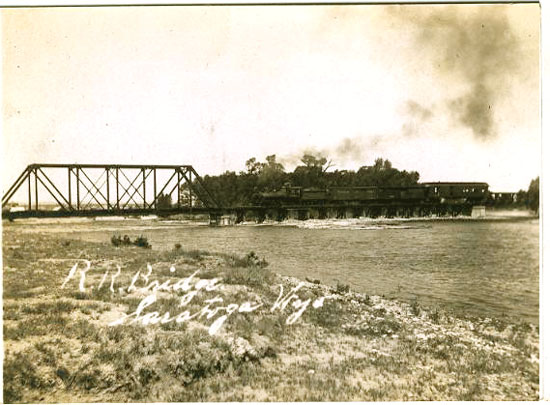
Train Crossing the Bridge at Saratoga, approx. 1910.
Combination
mail and passenger car at end of train.
In August 1907 the railroad arrived. At the time the line had, in addition to the box cars and a flat car, one locomotive and a combination
mail and passenger car. An additional locomotive and two passenger cars were, however, on their way from the east.
The coming of the railroad to Saratoga begat a huge celebration. The Sun proclaimed that Saratoga was now a
"railroad town." Senator Clark, Representative Mondell and the Governor Brooks were there. Governor Brooks recalled that
twenty-five years before he had ridden though the area on a pack animal. The Elks Lodge in Rawlins sent its band.
The Eastern Star put on an entertainment in Jensen Hall. There were foot races and a bronc contest. Hugh Clark won the saddle. But the big thing was the
Free Fish Fry at which over three thousand five hundred fish were served along with pickles, bread and butter, and Saratoga Chips. The Fish Fry became an annual
event.
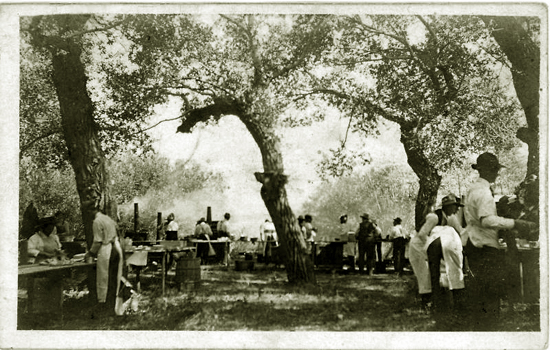
Fish Fry at Saratoga.
The following year, the railroad reached Encampment and it too celebrated with a fish fry.
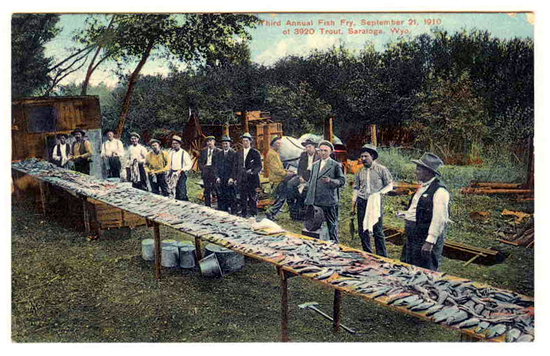
Third Annual Trout Fry at Saratoga, 1910.
The railroad cost $869,733.97 to construct. Its
roundhouse was in Encampment and by 1919 it had attained its final length of 44.732 miles. In that year, its total rolling stock
consisted of two locomotives, 22 freight cars and 2 passenger cars. The lack of a rotary, meant that there were blockages of the line in the winter.
In 1917 the line was blocked by snow and ice for eighty days before it could be reopened.
the railroad fell into the control one of its major bondholders, Morse Brothers Machinery and Supply Company of Denver. Morse
Brothers first leased and later sold the line to the Union Pacific.
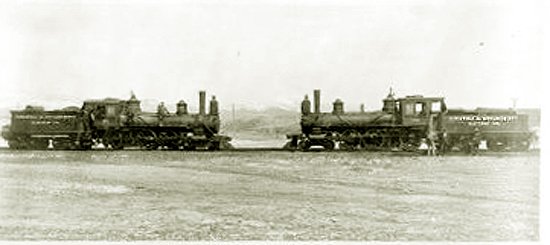
Saratoga and Emcampment Railway locomotives.
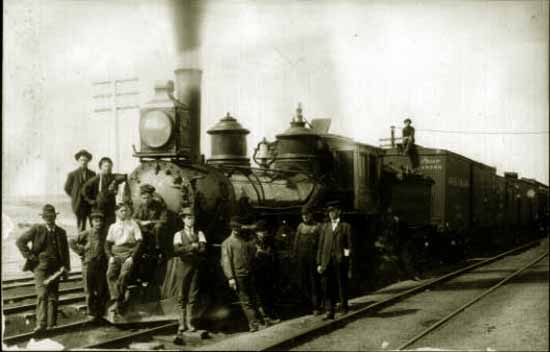
Saratoga and Emcampment Railway locomotive.
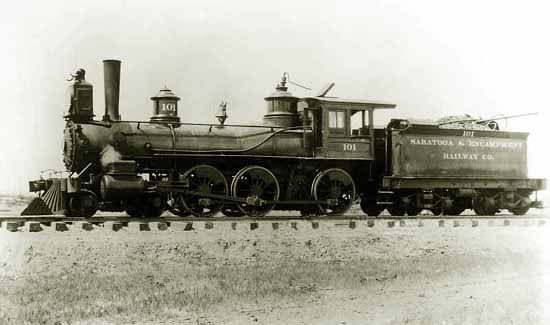
Saratoga and Emcampment Railway locomotive.
For more on the Saratoga and Encampment Railway Co., see
Encampment
Next page: Saratoga Continued
|